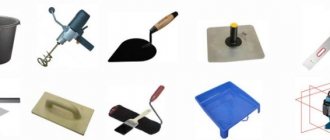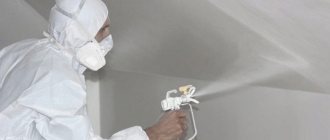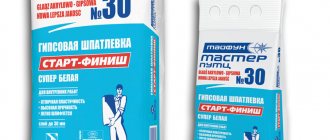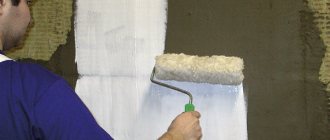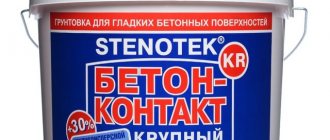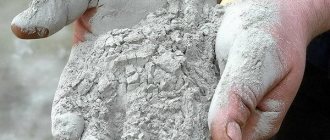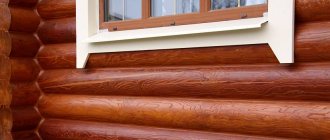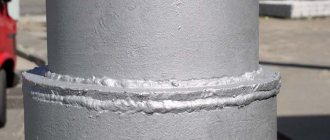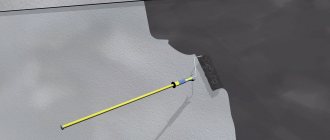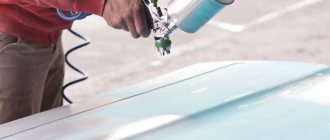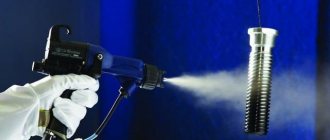Operating principle
A special feature of modifier primers is the presence of rust converters in their composition. Most often this is orthophosphoric acid. The principle of operation is based on the fact that oxidation products (rust) enter into a chemical reaction with the components of the primer and are converted into non-oxidizable compounds. This is why anti-corrosion primers can be applied over rust without cleaning the metal until it shines.
The transformed oxides form an additional protective film on the surface with good adhesive properties, so that subsequent protective coatings adhere well to the treated metal. The above properties are especially important if you need to treat surfaces in hard-to-reach places where it is difficult to completely remove rust.
All rust primers contain surfactants that increase the fluidity of the composition and improve its penetration to a thickness of up to 100 microns. However, no chemical substance can transform loose, crumbling rust, so it must be cleaned off, leaving only a hard-to-remove layer of oxides.
Where should a modifier primer not be used?
Scale is resistant to phosphoric acid, so applying a primer containing a rust converter to such surfaces is not recommended. If black rust has formed on the surface, this indicates that the alloy contains magnetite, which is also resistant to modifiers.
You cannot use compositions with rust modifiers on surfaces where oxidation has occurred partially and most of it is metal without corrosion. Uncleaned paint, like scale, will also not interact with the converter, and the primer will not be able to penetrate through it. If during operation the metal structure was exposed to sulfur, hydrogen sulfide or ammonia compounds, then the use of a primer based on orthophosphoric acid is also inappropriate.
Characteristics of primer for metal
A metal primer is a specialized solution that is applied to a metal surface to level it and protect it from corrosion. This material is used for processing metal surfaces both in industrial enterprises and at home. The primer is applied to the surface of any metal and forms a thin protective film that is resistant to moisture and temperature changes.
Currently, a large number of primers are produced for processing metal products. Today this is one of the most effective methods of protection against corrosion.
Table. Technical requirements according to GOST
| Indicator name | Meaning | Test method | |
| Organic primers | Water-dispersion primers | ||
| Primer performance. | |||
| 1 Mass fraction of non-volatile substances, %, not less | 13,0 | 48,0 | According to GOST 17537 |
| 2 Conditional viscosity at temperature (20±0.5) °C according to a viscometer type VZ-246, s | 13 — 180 | 30 — 180 | According to GOST 8420 |
| 3 Drying time: for natural drying primers to degree 3 at a temperature of (20±2) °C, h, no more than: | According to GOST 19007 and 9.4 of this standard | ||
| for epoxy primers | 36 | ||
| for everyone else | 24 | 5 | |
| for hot-drying primers, h, no more | 4 | 2 | |
| 4 Viability (shelf life) after mixing the components at a temperature of (20±2) °C, h, not less: | Not defined | According to GOST 27271 | |
| for epoxy primers | 4 | ||
| for everyone else | 6 | ||
| 5 Hazard class and subclass (flash point in a closed cup, °C): | According to GOST 19433 and 9.5 of this standard | ||
| 3.1 | Less than minus 18 | Less than minus 18 | |
| 3.2 | Minus 18 or more, but less than 23 | Minus 18 or more, but less than 23 | |
| 3.3 | 23 or more, but less than 61 | 23 or more, but less than 61 | |
| 9.1 | More than 61 but less than 90 | More than 61 but less than 90 | |
| Coverage indicators: 6 Appearance of cover | After drying, the primer should form a uniform surface without craters, pores or wrinkles. | After drying, the primer should form a uniform surface without craters, pores or wrinkles. | According to 9.6 of this standard |
| 7 Coating adhesion, points, no more | 2 | 2 | According to GOST 15140 |
| 8 Film elasticity when bending, mm, no more | 3 | 3 | According to GOST 6806 |
| 9 Resistance of the coating to static influence at a temperature of (20+2) °C, h, not less than - | According to GOST 9.403, method A and 9.7 of this standard | ||
| water | 24 | 24 | |
| sodium chloride solution with a mass fraction of 3% | 8 | 8 | |
| 10 Resistance of the coating to static exposure to chemically aggressive environments at a temperature of (20 ± 2) °C, h, not less | 2 | 2 | According to GOST 9403, method A and 9.8 of this standard |
We invite you to familiarize yourself with the main types of primer for metal exterior and interior work:
- Phosphating type primer - it contains two components, for the production of which a thinner and orthophosphoric acids are used. The primer has a wide range of applications and is suitable for metal surfaces of any type. After application to the surface, adhesion with any paint and varnish compositions significantly improves.
- Insulating type primer - consists of two primers connected to each other - epoxy and alkyd. Provides reliable protection of metal from high humidity. Zinc-based beryl is used as additional substances in the primer. It is most often used on black metal surfaces, but it can also be used on non-ferrous metals.
- Passivating type primer - prevents the development of corrosion on metal surfaces. This effect is achieved by reducing the electrochemical characteristics of metal surfaces.
- Inhibitory type primer - after application, it is capable of forming a special film on the metal surface, which not only prevents corrosion of the metal, but also provides its protection from mechanical damage. This property can be achieved due to the fact that the material contains zinc. An excellent product for metal surfaces located outside and subject to constant exposure to moisture.
- Anti-corrosion primer options are used for application to metal surfaces that were previously subject to corrosive processes. However, before applying the primer, the surface must be thoroughly cleaned of rust and sanded. After applying the primer, a film is formed on the metal, protecting it from moisture and, accordingly, from corrosion.
- Primer for metal against rust converter is the simplest version of primer for metal. If a metal object was previously covered with rust, then it is enough to apply a primer to its surface and the corrosion will be converted into self-destructive compounds. The primer composition is characterized by the presence of special substances that quickly penetrate into the rust-covered surface and destroy it. The same method is used to remove paint from metal objects. It is enough to cover it with this solution and the surface will clean itself. After this, it is recommended to coat the metal surface with a passivating primer to further protect it from corrosion.
Phosphating
A mixture based on orthophosphate acid along with solvents. A universal type of composition that can be combined with different types of metal surfaces. It is recommended to apply to surfaces that do not have corrosion. Then the material dries quickly.
They have the following positive qualities:
- After priming metal surfaces, adhesion is increased;
- Combination with paints based on epoxy or ethanol, alkyd;
- High-level heat resistance with the ability to withstand 150-200 degrees above zero;
- A surface with dielectric properties after application, including when using the alkyd variety.
Low protection against corrosion in some cases is the only drawback. Typically used on galvanized surfaces, steel or aluminum. It is better to exclude the aqueous composition under such conditions.
A universal type of composition that can be combined with different types of metal surfaces.
Passivating
It is important to purchase solutions that have a high concentration of chromium salts in the composition. If it is low, the corrosion processes only intensify. Due to some varieties, the state of metals becomes passive from active.
Anti-corrosion composition often includes:
- Zinc;
- Lead;
- Calcium;
- Barium;
- Strontium chromates.
After using this composition, metal products simply stop interacting with the environment. Dichromate salts are an excellent option for protecting aluminum structures. The deep type of penetration also protects them.
After using this composition, metal products simply stop interacting with the environment.
Isolating
From neutral pigments, an excellent example of which is red lead. It helps create a film on the surface with increased resistance to moisture. But the rusting process is still activated, since the protective effect itself does not last long.
It helps create a film on the surface with increased resistance to moisture.
Transformative
Allows use with products on which corrosion has already appeared. Characteristic is the appearance of another compound from rust, followed by immediate splitting. Mixtures are created from surfactants that provide easy penetration into the metal structure. It is recommended to use passivating options together with transformative ones.
Allows use with products on which corrosion has already appeared.
Tread
Rust control products. The composition often contains powders with aluminum and zinc, magnesium. The effectiveness of work for a specific situation is determined by the concentration of substances. Work more efficiently when the total quantity increases. Zinc dust is the most popular.
The effectiveness of work for a specific situation is determined by the concentration of substances.
Inhibitory
Protection of metal from harmful influences over a wide range of applications. As a result of processing, the metal is coated with enamel primer. The inhibitors themselves require dissolution in water or oil, with equal effectiveness.
Protection of metal from harmful influences over a wide range of applications.
Alkyd
With a passivating and insulating effect at the same time. The composition contains fillers based on whitewash, red lead and similar substances. A universal mixture for creating improved adhesion with other finishing and decorative materials. A good type of installation under alkyd paints.
A universal mixture for creating improved adhesion with other finishing and decorative materials.
Description of the red-brown primer GF-021
The primer is intended for priming surfaces made of various materials (from wood to metal surfaces). It is imperative to use a primer on the surface if the next stage of processing any surface is coating with enamel and other similar emulsions.
Primer GF-021 is a fairly common construction composition today. It gained its popularity due to its versatility, because it can be used indoors in any room and is also suitable for outdoor work.
The paint and varnish composition in question is a mixture of pigment fillers dissolved in an alkyd-type varnish (the main additives here are solvent emulsions, stabilizing substances, etc.).
This primer is used when a comprehensive surface coating is required (it goes well with other finishing and decorative paint-type materials). The use of the material outside is due to its high resistance to various kinds of temperature changes and other climatic conditions. Among other things, it can also be used as a base coating for any type of surface.
Tips and recommendations for use
Before choosing a composition, it is important to consider the conditions under which the operation will be carried out. This is especially true for humidity and temperature. Don't forget about direct ultraviolet rays. It is worth remembering that when using different tools, different effects appear. For example, a roller increases consumption.
Instructions from the manufacturer for stirring and applying the compositions are required to be studied before starting work. In most cases, preparation work is done like this:
- Old paint layers are removed by firing, grinding machines or an abrasive brush.
- The metal is cleaned until only the natural coating remains. You need to make sure that only the rough part remains on top. Only in this case will there be no doubt about the reliability of the clutch.
- First, apply the first layer of metal primer and wait until it dries completely. And they move on to the second.
The initial and final coatings are also considered before selection. After all, some materials may simply be incompatible with each other.
Alcohol-based metal primers are the easiest to use. They dry quickly and do not require additional care. Excess corrosion is cleaned with a brush, even when highly specialized compounds are used. It is recommended to apply the compositions before this or that item is again used in the environment, especially at elevated temperatures.
Where can I buy the right primer for metal?
The answer to this question is a continuation of the previous topic. You can now easily find out how much a particular metal primer costs and what its rating is from the Internet. Just scroll through the pages of online stores and study the current prices for the products you need. To compare the results, all numbers must be reduced to a common denominator. That is, the comparison should not include the price per package, but the price per 1 kg or price per liter.
Attention! Since Russia is one of those countries where there are still a lot of counterfeit goods, including metal primers, you should only buy the latter in reliable stores.
A particularly reliable way to purchase is through the website of the manufacturing company. On our website you can find out all the technical details of the product, as well as the real cost - what retail and wholesale will cost. All prices without intermediary surcharges. The company works using the most modern materials from the best suppliers, as well as advanced technologies, including organizational ones, such as contract manufacturing. GOODHIM specialists are always ready to dialogue with clients and can choose the most advantageous offer for each.
Options for primer mixtures for metal
There are several common processing solutions that help facilitate final processing of the product and improve its performance:
- Alkyd primers are a very common option and are used most often. It consists of an alkyd composition in the base, with the use of various stabilizing substances and additives. The color of the coating is gray or brown. It is highly durable and dries quickly. Also contains: red lead, whitewash and other components. Compatible with almost any type of final coating.
- Products consisting mostly of orthophosphoric acid. It is used for surface types that are already slightly affected by corrosion. The solution helps restore the material and free it from rust. Phosphorus primers stop all oxidative processes and, as a result, strengthen the product. When using such products, it is imperative to remove rust from the surface being treated.
- Acrylic, water-dispersed options are used indoors, increase adhesion, and level the surface. This composition dries quickly and is suitable for coating iron surfaces and alloys of non-ferrous metals.
- Inhibiting primer. This composition does not form a general film over the product, but penetrates directly into the surface at the molecular level. As a result, some properties of the material change, it becomes denser and harder. When processed, they combine the properties of the primer mixture itself and the enameled surface. Every day such coatings for various metal surfaces are becoming more and more in demand.
- Protective. This product contains magnesium and zinc. The higher the content of powders in this mixture, the higher quality it is considered. Particularly popular are compounds that contain red lead. Thanks to these components, the metal surface hardens and even the smallest scratches do not form on it. Ideal for those structures and products that have frequent contact with fresh and sea water.
- Converter. A variant of a mixture that is mixed with a corrosive coating. As a result, the structure of these stains becomes more porous and can be easily removed from the metal surface. Therefore, at the beginning of work on such material, it is not necessary to clean off rusty areas from the surface. Therefore, transformative compounds are an option for the lazy.
- Insulating mixtures. In this version, the base is a neutral pigment. But the primer itself has a short shelf life.
Each subtype of soil mixture has its own characteristics, which should be clarified when selecting. It must be suitable for the type of metal that is supposed to be processed.
The optimal characteristics for a standard metal primer are:
- semi-gloss or matte type of film;
- the period during which the mixture dries should be no more than 12 hours;
- elasticity parameters of the finished film without taking into account bending - no more than 1;
- conditional viscosity parameters more than 45.
This primer will significantly increase the service life of the metal surface and paintwork.
Primer for metal price and features of choice
There are certain criteria for choosing a primer for metal; adhering to them, it is possible to choose a material that copes well with the tasks assigned to it.
First of all, decide on the type of metal that can be processed. Next, determine the functional purpose of the primer composition. You should also take into account the conditions under which the primer will be applied to the surface, these are humidity and temperature, the presence of direct ultraviolet rays. Next, take into account the tool that is intended for applying the primer, it can be a roller, brush or spray gun. Applying primer with a roller increases material consumption and is only relevant when work is carried out on a large surface area. The brush is a standard option, suitable for any surface. If the object is still voluminous, then it is better to use a spray bottle, which will not only reduce material consumption, but will also evenly cover the entire metal object.
The amount of primer used on metal is determined by various factors, among which the type of surface, the number of layers applied to it, etc. should be highlighted. When using frost-resistant compounds, before applying them, the metal is coated with a moisture-repellent primer. When purchasing a primer for metal, it is also necessary to purchase equipment in the form of gloves, a respirator and goggles that provide protection for the person working with the primer. It is especially important to use these products when working with a sprayer.
Main nuances
In order for the result of surface coating to be positive, it is necessary to pay attention to all the nuances associated with handling such an emulsion.
It can be used with finishing enamels and all types of putty, both outdoors and indoors. Before direct use, as mentioned earlier, it must be brought to the desired consistency by diluting it with a solvent.
Primer consumption averages 55-105 g/m² (this figure may depend on the quality of the preparatory work, the material of the surface itself, the equipment used for painting, etc.)
Primer for metal against rust.
The product is protected from corrosion by an anti-corrosion passivating primer for metal ; it also reduces the electrochemical characteristics of the metal. The most commonly used brand is GF-0119.
A protective material from external influences, the so-called enamel primer, is created by an inhibitory primer on the metal surface after work has been carried out and dried. It has an anti-corrosion effect. The mixture can be oil- or water-based, but most often it combines both of these materials. The most suitable primer for processing is EP-0180.
The protective fire-retardant mixture contains zinc, which protects the metal even when scratches appear on it; this is ensured by the protective film that appears on its surface after the mixture is applied and dried. Metal products located outdoors, thanks to a galvanized coating for outdoor use, will be well protected from temperature changes and moisture. The most commonly used mixtures are EP-057 and EP-0284.
For metal products that have already been rusted and corroded, a rust repair mixture has been developed. This metal primer helps to partially restore the coating and provides protection from new corrosion, but before starting work, the metal surface must be thoroughly cleaned of rust and then sanded. This primer is capable of transforming corrosion, thus protecting the metal; on the coating, the fire-retardant mixture, after drying, creates a polymer film that protects the metal from water. The composition most often chosen for processing is EP-0199 or XB-0278.
It is easiest to work with a transformative type of primer mixture. metal primer does not require preliminary cleaning to remove rust . The water-based chemicals included in its composition allow the mixture to transform and destroy rust. After this, a strong film is created on the surface of the product.
If a large surface area has been rusted and it crumbles when touched, then you must first clean the metal and then only apply a primer.
The paint is exposed to the mixture in the same way: the mixture can be applied directly to the old layer if it is strong, but when the paint peels off, it must be cleaned off before starting work. This fire-retardant primer is used most often with other types of mixture, since it only copes well with the transformation of rust, but does not create a full-fledged protective film on the surface. This mixture can be used with almost any type of coating.
Primer for metal and everything you need to know about it.
In the modern world, there are a large number of materials that are used to protect against corrosion. They cover the metal surface with a thin layer of film, which prevents iron and other types of metals from oxidizing. Many types of anti-corrosion agents are applied immediately before paint coatings. One of these products is metal primer.
Operating principle
A special feature of modifier primers is the presence of rust converters in their composition. Most often this is orthophosphoric acid. The principle of operation is based on the fact that oxidation products (rust) enter into a chemical reaction with the components of the primer and are converted into non-oxidizable compounds. This is why anti-corrosion primers can be applied over rust without cleaning the metal until it shines.
The transformed oxides form an additional protective film on the surface with good adhesive properties, so that subsequent protective coatings adhere well to the treated metal. The above properties are especially important if you need to treat surfaces in hard-to-reach places where it is difficult to completely remove rust.
All rust primers contain surfactants that increase the fluidity of the composition and improve its penetration to a thickness of up to 100 microns. However, no chemical substance can transform loose, crumbling rust, so it must be cleaned off, leaving only a hard-to-remove layer of oxides.
Where should a modifier primer not be used?
Scale is resistant to phosphoric acid, so applying a primer containing a rust converter to such surfaces is not recommended. If black rust has formed on the surface, this indicates that the alloy contains magnetite, which is also resistant to modifiers.
You cannot use compositions with rust modifiers on surfaces where oxidation has occurred partially and most of it is metal without corrosion. Uncleaned paint, like scale, will also not interact with the converter, and the primer will not be able to penetrate through it. If during operation the metal structure was exposed to sulfur, hydrogen sulfide or ammonia compounds, then the use of a primer based on orthophosphoric acid is also inappropriate.
Characteristics of primer for metal
A metal primer is a specialized solution that is applied to a metal surface to level it and protect it from corrosion. This material is used for processing metal surfaces both in industrial enterprises and at home. The primer is applied to the surface of any metal and forms a thin protective film that is resistant to moisture and temperature changes.
Currently, a large number of primers are produced for processing metal products. Today this is one of the most effective methods of protection against corrosion.
Table. Technical requirements according to GOST
| Indicator name | Meaning | Test method | |
| Organic primers | Water-dispersion primers | ||
| Primer performance. | |||
| 1 Mass fraction of non-volatile substances, %!, not less | 13,0 | 48,0 | According to GOST 17537 |
| 2 Conditional viscosity at temperature (20±0.5) °C according to a viscometer type VZ-246, s | 13 — 180 | 30 — 180 | According to GOST 8420 |
| 3 Drying time: for natural drying primers to degree 3 at a temperature of (20±2) °C, h, no more than: | According to GOST 19007 and 9.4 of this standard | ||
| for epoxy primers | 36 | ||
| for everyone else | 24 | 5 | |
| for hot-drying primers, h, no more | 4 | 2 | |
| 4 Viability (shelf life) after mixing the components at a temperature of (20±2) °C, h, not less: | Not defined | According to GOST 27271 | |
| for epoxy primers | 4 | ||
| for everyone else | 6 | ||
| 5 Hazard class and subclass (flash point in a closed cup, °C): | According to GOST 19433 and 9.5 of this standard | ||
| 3.1 | Less than minus 18 | Less than minus 18 | |
| 3.2 | Minus 18 or more, but less than 23 | Minus 18 or more, but less than 23 | |
| 3.3 | 23 or more, but less than 61 | 23 or more, but less than 61 | |
| 9.1 | More than 61 but less than 90 | More than 61 but less than 90 | |
| Coverage indicators: 6 Appearance of cover | After drying, the primer should form a uniform surface without craters, pores or wrinkles. | After drying, the primer should form a uniform surface without craters, pores or wrinkles. | According to 9.6 of this standard |
| 7 Coating adhesion, points, no more | 2 | 2 | According to GOST 15140 |
| 8 Film elasticity when bending, mm, no more | 3 | 3 | According to GOST 6806 |
| 9 Resistance of the coating to static influence at a temperature of (20+2) °C, h, not less than - | According to GOST 9.403, method A and 9.7 of this standard | ||
| water | 24 | 24 | |
| sodium chloride solution with a mass fraction of 3%! | 8 | 8 | |
| 10 Resistance of the coating to static exposure to chemically aggressive environments at a temperature of (20 ± 2) °C, h, not less | 2 | 2 | According to GOST 9403, method A and 9.8 of this standard |
We recommend: How to treat drywall before wallpapering
We invite you to familiarize yourself with the main types of primer for metal exterior and interior work:
- Phosphating type primer - it contains two components, for the production of which a thinner and orthophosphoric acids are used. The primer has a wide range of applications and is suitable for metal surfaces of any type. After application to the surface, adhesion with any paint and varnish compositions significantly improves.
- Insulating type primer - consists of two primers connected to each other - epoxy and alkyd. Provides reliable protection of metal from high humidity. Zinc-based beryl is used as additional substances in the primer. It is most often used on black metal surfaces, but it can also be used on non-ferrous metals.
- Passivating type primer - prevents the development of corrosion on metal surfaces. This effect is achieved by reducing the electrochemical characteristics of metal surfaces.
- Inhibitory type primer - after application, it is capable of forming a special film on the metal surface, which not only prevents corrosion of the metal, but also provides its protection from mechanical damage. This property can be achieved due to the fact that the material contains zinc. An excellent product for metal surfaces located outside and subject to constant exposure to moisture.
- Anti-corrosion primer options are used for application to metal surfaces that were previously subject to corrosive processes. However, before applying the primer, the surface must be thoroughly cleaned of rust and sanded. After applying the primer, a film is formed on the metal, protecting it from moisture and, accordingly, from corrosion.
- Primer for metal against rust converter is the simplest version of primer for metal. If a metal object was previously covered with rust, then it is enough to apply a primer to its surface and the corrosion will be converted into self-destructive compounds. The primer composition is characterized by the presence of special substances that quickly penetrate into the rust-covered surface and destroy it. The same method is used to remove paint from metal objects. It is enough to cover it with this solution and the surface will clean itself. After this, it is recommended to coat the metal surface with a passivating primer to further protect it from corrosion.
Primer for metal price and features of choice
There are certain criteria for choosing a primer for metal; adhering to them, it is possible to choose a material that copes well with the tasks assigned to it.
First of all, decide on the type of metal that can be processed. Next, determine the functional purpose of the primer composition. You should also take into account the conditions under which the primer will be applied to the surface, these are humidity and temperature, the presence of direct ultraviolet rays. Next, take into account the tool that is intended for applying the primer, it can be a roller, brush or spray gun. Applying primer with a roller increases material consumption and is only relevant when work is carried out on a large surface area. The brush is a standard option, suitable for any surface. If the object is still voluminous, then it is better to use a spray bottle, which will not only reduce material consumption, but will also evenly cover the entire metal object.
The amount of primer used on metal is determined by various factors, among which the type of surface, the number of layers applied to it, etc. should be highlighted. When using frost-resistant compounds, before applying them, the metal is coated with a moisture-repellent primer. When purchasing a primer for metal, it is also necessary to purchase equipment in the form of gloves, a respirator and goggles that provide protection for the person working with the primer. It is especially important to use these products when working with a sprayer.
We recommend: Primer for rust: types of primer compositions and technology for preparing metal for painting
Primer for metal against rust.
The product is protected from corrosion by an anti-corrosion passivating primer for metal ; it also reduces the electrochemical characteristics of the metal. The most commonly used brand is GF-0119.
A protective material from external influences, the so-called enamel primer, is created by an inhibitory primer on the metal surface after work has been carried out and dried. It has an anti-corrosion effect. The mixture can be oil- or water-based, but most often it combines both of these materials. The most suitable primer for processing is EP-0180.
The protective fire-retardant mixture contains zinc, which protects the metal even when scratches appear on it; this is ensured by the protective film that appears on its surface after the mixture is applied and dried. Metal products located outdoors, thanks to a galvanized coating for outdoor use, will be well protected from temperature changes and moisture. The most commonly used mixtures are EP-057 and EP-0284.
For metal products that have already been rusted and corroded, a rust repair mixture has been developed. This metal primer helps to partially restore the coating and provides protection from new corrosion, but before starting work, the metal surface must be thoroughly cleaned of rust and then sanded. This primer is capable of transforming corrosion, thus protecting the metal; on the coating, the fire-retardant mixture, after drying, creates a polymer film that protects the metal from water. The composition most often chosen for processing is EP-0199 or XB-0278.
It is easiest to work with a transformative type of primer mixture. metal primer does not require preliminary cleaning to remove rust . The water-based chemicals included in its composition allow the mixture to transform and destroy rust. After this, a strong film is created on the surface of the product.
If a large surface area has been rusted and it crumbles when touched, then you must first clean the metal and then only apply a primer.
The paint is exposed to the mixture in the same way: the mixture can be applied directly to the old layer if it is strong, but when the paint peels off, it must be cleaned off before starting work. This fire-retardant primer is used most often with other types of mixture, since it only copes well with the transformation of rust, but does not create a full-fledged protective film on the surface. This mixture can be used with almost any type of coating.
Choosing a mixture for primer for metal.
There are many criteria that a metal primer , so there is no need to rush and purchase the first mixture you come across.
It is necessary, first of all, to take into account the types of metal that will be processed, as well as the working conditions (whether the metal was exposed to low or high temperatures, sunlight, humidity, what kind of coating and how long it takes to dry).
The tools that will be needed during the work are also important. The metal primer applied using a brush, a special sprayer or a roller. Sold in liquid form or in cans.
It is faster and easier to use a sprayer, but if the aerosol fire retardant mixture is used in cans, then the consumption increases and this factor must also be taken into account.
The standard consumption is for an aerosol mixture in cans and another primer for metal : less than 14 g per m², but this figure may increase or decrease, depending on the type of surface being treated.
Metal primer is always applied in two layers , which is why the material consumption also increases, and this despite the fact that the second layer will require much less primer than the first.
Some people apply a third layer of a special mixture before painting, which creates a moisture-proof coating, and this further increases consumption. The third layer is most often done using a heat-resistant alkyd mixture. This additional layer will be very useful, since the metal is often exposed to sunlight, water and low temperatures outside.
This heat-resistant mixture is applied at a certain temperature (from -10 to +27 °C).
Acrylic primer for metal is suitable if you need a quick-drying water-based mixture; it has the fastest drying speed. The acrylic mixture is completely safe for the atmosphere and humans; it is well suited for use at home, and especially in small spaces, since it does not have an unpleasant odor. This mixture helps improve adhesion to the final coating, and also helps to level the surface, make coating defects less noticeable and allows you to mask a previously applied coating. However, only some types of this material are suitable for work before painting; for example, you cannot paint an acid primer, the paint simply will not adhere to it, and then white spots and streaks will appear.
We recommend: Various types of floor primers
In general, the acrylic mixture is good for use before painting; it leaves a durable protective layer on the surface and has a low material consumption per m2. This mixture can be sanded after applying the finishing layer and completing the work. The color of the mixture may also vary: it can be gray, colorless or colored; most often a gray aerosol primer for metal is used.
In use, you can often find materials based on acrylic styrene, which contain various organic elements, resins and pigments. But this mixture does not protect against exposure to sunlight, since it does not contain ester groups that can destroy alkyds.
An alkyd fire-retardant heat-resistant mixture is best suited for protecting metal, not only for private small structures, but also for production equipment and large facilities such as hangars. It is applied to the surface in 1-2 layers, then paint is applied on top. The time it takes to apply depends on how long the mixture dries (you can check with the manufacturer).
It is also important to pay attention to the hardeners and solvents that will be used.
Before buying a mixture, you need to calculate exactly how much it will be needed and determine whether it dries quickly. Approximate consumption is most often indicated per package, but consumption can be significantly higher, depending on the type of surface being treated.
When carrying out priming work, it is important to know not only how long the mixture dries, but also how long it retains its properties. For acrylic mixtures, the time is no more than 1 hour, so you need to apply the material immediately, without leaving it outdoors or indoors for a long time. The primer is immediately applied to the entire area using a spray or broad strokes. You cannot take breaks in applying the material, so the required amount of the mixture must be purchased in advance.
It should not be forgotten that the material must match the surface being processed and the quality characteristics of the metal should benefit from it.
When purchasing a mixture that will be used to prime metal , you need to consult how much paint or other final coating is needed and what type of paint is best suited for the selected primer.
